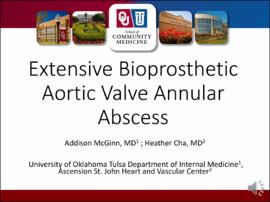| dc.description.abstract | Case Introduction: Infective endocarditis (IE) is a relatively common, usually subacute infection involving heart valves. IE is often preceded by bacteremia in patients with prosthetic hardware, artificial heart valves, vascular access catheters, or in patients with risk factors such as intravenous drug use. Normally, IE is found during work-up for bacteremia and is best evaluated with echocardiography. Prolonged IV antibiotics are the treatment of choice unless the patient has an indication for surgery such as a large vegetation or signs acute heart failure, among others.
Case Description: A 75-year-old male with a past medical history of aortic stenosis status-post bioprosthetic aortic valve (AV) replacement presented with back pain. At the time of admission, labs were notable for acute kidney injury, transaminase elevation, leukocytosis, and lactic acidosis. Subsequent blood cultures grew Enterococcus faecalis. Transthoracic echocardiography confirmed endocarditis with a mobile mass involving the tricuspid valve (TV). Transesophageal echocardiography further demonstrated a large bioprosthetic aortic valve annular abscess extending into the ascending and descending aorta. Direct visualization in the OR confirmed native TV endocarditis and an AV annular abscess eroding into the atria and left ventricular outflow tract (LVOT). He underwent AV/LVOT abscess debridement, repair of aortic root using autologous pericardium with coronary reimplantation, and TV debridement and repair. His postoperative course was complicated by ventricular tachycardia and refractory cardiogenic shock secondary to right ventricular failure. He was transferred to an outlying facility for extracorporeal membrane oxygenation (ECMO) support, but ultimately passed away. Just two weeks prior to this aforementioned admission, the patient underwent transthoracic echocardiography for new onset atrial fibrillation which demonstrated a bioprosthetic aortic valve with normal pressure gradients and without vegetation.
Case Discussion: The incidence of perivalvular abscess among patients with bioprosthetic valve endocarditis is between 30% to 40%. What makes this case interesting is not only the impressive local extent of abscess, but also the aggressive nature of the infection given negative imaging just weeks prior. This case illustrates the need for rapid identification, early initiation of treatment, and availability of post-operative mechanical support for patients with bioprosthetic valve abscess from endocarditis.
Ramos Tuarez FJ, Yelamanchili VS, Law MA. Cardiac Abscess. [Updated 2020 Jul 17]. In: StatPearls [Internet]. Treasure Island (FL): StatPearls Publishing; 2020 Jan-. Available from: https://www.ncbi.nlm.nih.gov/books/NBK459132/ | en_US |
